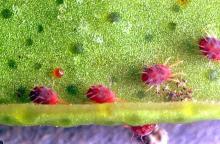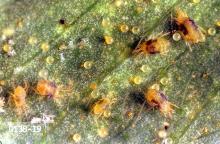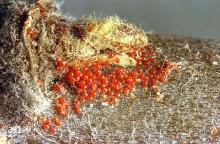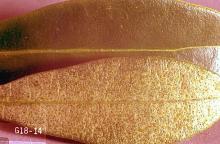Brown mite (Bryobia rubrioculus)
European red mite (Panonychus ulmi)
McDaniel mite (Tetranychus mcdanieli)
Twospotted spider mite (Tetranychus urticae)
Yellow spider mite (Eotetranychus carpini borealis)
For mite identification, see:
Field Characteristics of Fruit-Tree-Attacking Spider Mites in the PNW
Pest description and crop damage All adult mites are small, usually only about 0.02 inch in length and have eight legs. The various apple-infesting species vary in appearance as follows:
- Brown mite: The adult female is a dull reddish brown with dark orange markings, and somewhat flattened. The front legs are very long, over twice the length of the other legs, and extend forward from the body.
- European red mite: Adults are globular and reddish with white spines. Immatures are similar in appearance, only smaller. The eggs are red and globular.
- Twospotted or McDaniel mite: Adults are yellowish-brown, about 0.02 inch in length. Twospotted mites have two dark spots on the body, while McDaniel mites have four. Immatures are similar in appearance, only smaller. Eggs are round and translucent to opaque.
- Yellow spider mite: Adult females are pale yellow to white with 2 or 3 dark, rectangular markings on each side of the abdomen. Immatures are similar in appearance to the two-spotted spider mite, but have more of a yellowish color. Eggs are clear and spherical.
Spider mites damage leaves by puncturing cells and sucking out the contents. This produces small yellow-white spots on the upper leaf surface. In heavy infestations, the spots coalesce and the leaf yellows or bronzes.
Biology and life history Twospotted, McDaniel and yellow spider mites overwinter as fertilized females under bark or in soil debris. European red mites and brown mites overwinter as eggs in crevices of twig bark and young limbs. They move to young foliage when buds break in spring and produce many generations during spring to autumn. Females can lay up to 10 eggs per day and more than 200 during their lifetime. Egg-to-adult development can occur in 7 to 10 days during summer. They thrive under hot, dry conditions. Large colonies of mites produce webbing. Dispersal occurs mainly through wind transport.
Scouting and thresholds Thresholds have not been established, but economic damage is unlikely at levels below 15 to 20 per leaf. Treatment thresholds always must consider the presence of predatory mites, which are major biological control agents (see below).
Management-biological control
Spider mite populations are held down by cool, wet conditions early in the season. Considerable natural control is provided by lady beetles (Stethorus spp.) and minute pirate bugs (Orius spp.). Predatory mites such as Typhlodromus spp. or Neoseiulus fallacis (syn. Amblyseius fallacis) are also effective at managing populations of spider mites and may be purchased. Avoid broad-spectrum insecticide sprays to protect predators.
Management-cultural control
Spider mite infestations are favored by dry, dusty conditions, so avoid creating these problems and stressing the plants. The use of cover crops also reduces dust and mite problems. Broadleaf weeds like mallow, bindweed, white clover, and knotweed enhance mite numbers. Suppression of these weeds with cultivation or grasses may reduce mite numbers. Mites may be washed from the tree with a strong stream of water. Water trees properly, as drought-stressed trees are more susceptible. Avoid excessive nitrogen applications, as this encourages mites.
Management-chemical control: HOME USE
Stages 0-1: dormant & delayed-dormant spray
horticultural mineral oil-Some formulations OMRI-listed for organic use.
Spring and summer
- azadirachtin (neem oil)-Some formulations are OMRI-listed for organic use.
- gamma-cyhalothrin-Highly toxic to bees.
- insecticidal soap-Avoid spraying when blossoms are open. May require several applications. Some formulations are OMRI-listed for organic use.
- lambda-cyhalothrin-Highly toxic to bees.
- malathion-Highly toxic to bees.
- permethrin-Highly toxic to bees.
- plant-derived essential oils-Some have shown efficacy against spider mites. Some formulations are OMRI-listed for organic use.
- pyrethrins-Some formulations are OMRI-listed for organic use.
- spinosad-Highly toxic to bees. Some formulations are OMRI-listed for organic use.
- sulfur-Some formulations are OMRI-listed for organic use.
Management-chemical control: COMMERCIAL USE
Stages 0-1: Egg control with dormant & delayed-dormant sprays
- hexythiazox (Savey 50WP) at 3 to 6 oz/A in up to 100 gal water per application. To avoid resistance development, apply hexythiazox only once per season. Hexythiazox is an ovicide and will not control adult mites: combine with adulticide if adults are present. REI 12 hr. [Group 10A]
- horticultural mineral oil at 6 to 8 gal/A in up to 400 gal water. REI varies by formulation; see label. Some formulations are OMRI-listed for organic use.
- sulfur (dry flowable)- Formulations vary; see label for rates. Apply with suitable spray oil during bud dormancy only. REI 24 hr. Some formulations are OMRI-listed for organic use. Potential for phytotoxicity with hot temperatures and with sensitive apple varieties.
- lime sulfur (calcium polysulfide)-Formulations vary; see label for rates. May be mixed with horticultural mineral oil at 6 to 8 gal/A in up to 400 gal water. REI 2 days. Some formulations are OMRI-listed for organic use.
- micronized wettable sulfur (Microthiol Disperss) 10 to 20 lb/A. Dilute applications 100 to 800 gal water, concentrated applications 20 to 100 gal. Note: certain apple varieties may be sensitive to sulfur. REI 24 hr. OMRI-listed for organic use.
Stages 3-4: Egg Control with Prepink & tight cluster sprays
- clofentezine (Apollo SC) at 4 to 8 oz/A per growing season. To avoid resistance development, apply Apollo only once per season. Apollo is an ovicide and will not control adult mites. REI 12 hr. [Group 10A]
- hexythiazox (Savey 50DF) at 3 to 6 oz/A in up to 100 gal water per application. To avoid resistance development, apply hexythiazox only once per season. Hexythiazox is an ovicide and will not control adult mites. Combine with adulticide if adults are present. REI 12 hr. [Group 10A]
Spring and summer
Choice of miticide varies with species of mite present, selectivity to predatory mites, and other factors, such as resistance present in an area.
- abamectin (Abamex) at 10 to 20 oz/A in up to 100 gal water per application. Apply when mites first appear. Apply only during petal fall and up to six weeks following petal fall. Do not apply more than two applications per growing season. REI 12 hr. PHI 28 days. [Group 6]
- acequinocyl (Kanemite 15SC) at 21 to 31 fl oz/A in up to 100 gal water per application. Do not exceed two applications per season. REI 12 hr. PHI 14 days. [Group 20B]
- bifenazate (Acramite 50WS) at 0.75 to 1 lb of product/A in up to 100 gal water per application. Do not exceed one application per season. Do not use with oil on Golden Delicious due to risk of phytotoxicity. REI 12 hr. PHI 7 days.
- clofentezine (Apollo SC) at 4 to 8 oz/A in up to 100 gal water per application. Do not exceed one application of Apollo per season. Apollo is an ovicide and will not control adult mites. REI 12 hr. PHI 45 days. [Group 10A]
- cyflumetofen (Nealta) at 13.7 fl oz/A in minimum of 100 gal water per application. Do not exceed two applications of Nealta per season. REI 12 hr. PHI 7 days. [Group 25]
- etoxazole (Zeal 72WDG) at 2 to 3 oz/A in up to 100 gal water per application. Only one application per season. REI 12 hr. PHI 14 days. [Group 10B]
- fenbutatin-oxide (Vendex 50WP) at 1 to 2 lb of product/A in up to 100 gal water per application. Do not apply more than two times per growing season. REI 2 days. PHI 14 days. [Group 12B]
- fenpyroximate (Fujimite 5SC) at 2 pints/A in a minimum of 100 gal water per acre. Also see Fujimite XLO. Only one application per season. Do not apply by alternate row middle spray method. REI 12 hr. PHI 14 days. [Group 21A]
- hexythiazox (Savey 50WP) at 3 to 6 oz/A in up to 100 gal water per application. To avoid resistance development, apply hexythiazox only once per season. Hexythiazox is an ovicide and will not control adults. Combine with adulticide if adults are present. REI 12 hr. PHI 28 days. [Group 10A]
- pyridaben (Nexter) at 6.6 to 10.67 oz/A in up to 100 gal water per application. Apply as populations begin to build, between petal fall and harvest. Do not exceed one application per season. Lower rates can be used for control of European red mite; higher rates are required for control of twospotted or McDaniel spider mites. Also controls apple rust mite. REI 12 hr. PHI 25 days. [Group 21]
- spirodiclofen (Envidor 2SC) at 16 to 18 fl oz product/A in a minimum of 100 gal water per application. Do not apply more than one application or 18 fl oz product/A per growing season. REI 12 hr. PHI 7 days. [Group 23]
Resistance management Spider mites develop resistance rapidly to chemical controls. Alternate chemistries and modes of action.





